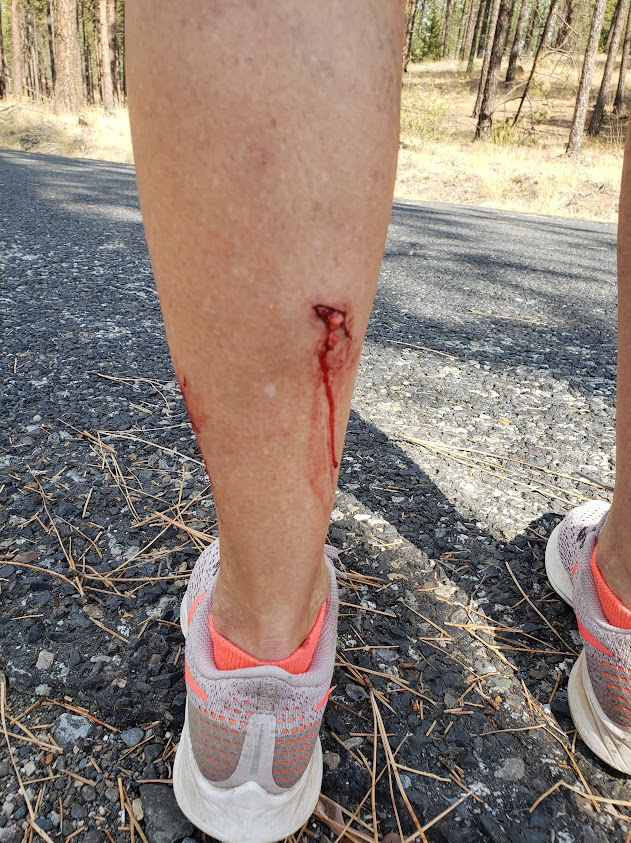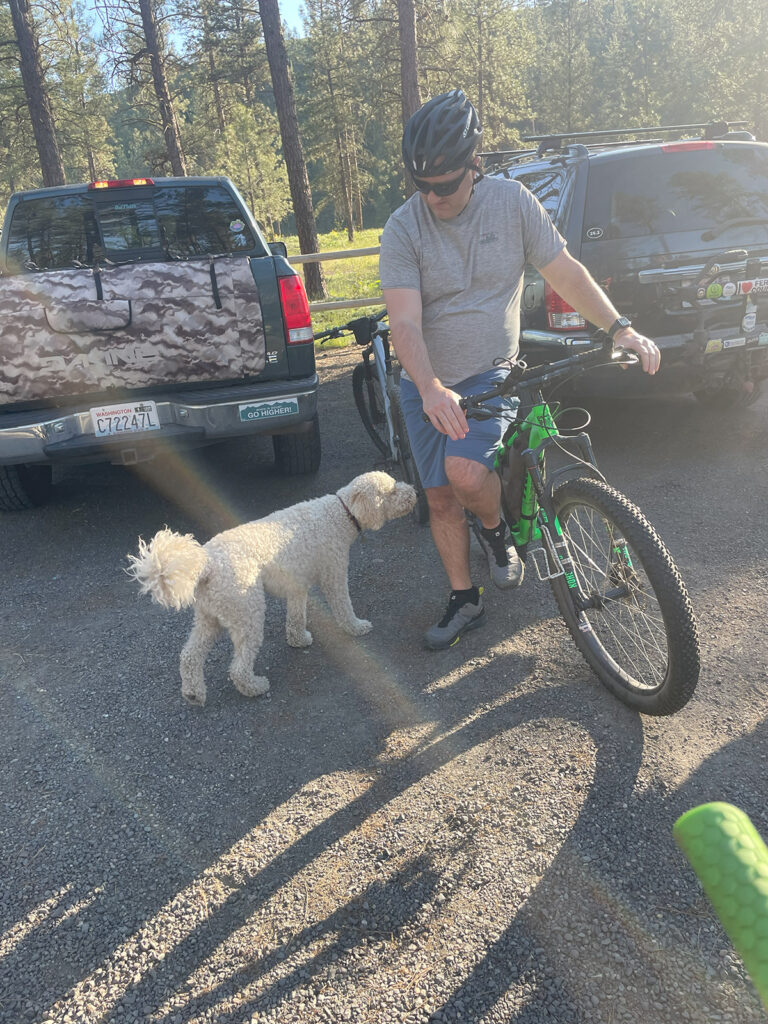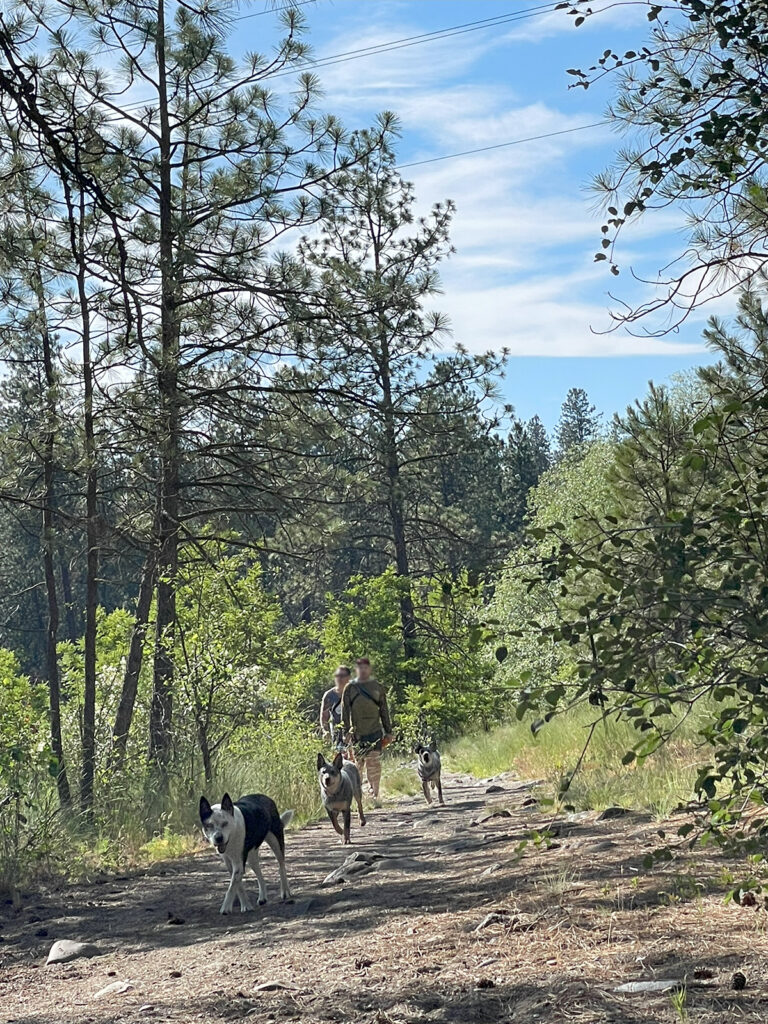In many outdoor spaces, leashes are the law, but some people still ignore it
Lou and Mary Haymond were walking on a trail in the Plese Flats area at Riverside State Park when an off-leash dog charged them from more than 150 feet away. Lou moved in front of Mary as it snarled and lunged at them, but the border collie ran around Lou and bit Mary’s leg. They did all the right things—avoiding eye contact and not running, but it didn’t matter. The dog drew blood and the puncture wounds were deep. At the emergency room, the decision was made not to stich the wound tightly due to the potential for infection. After the attack, the owner leashed the dog, apologized profusely and offered to pay medical bills. But the damage was done.

Dog attacks like this one often inspire a renewed focus on the topic of leashing your dog on public trails. While it’s the law in several areas, the rules in other public spaces are murkier. With more pups hitting the trails post-COVID, it is in everyone’s best interest to help create safe, positive interactions on the trail. It starts with knowing the rules and comes down to respecting others in the outdoors community.
Don’t Worry! My Dog is Friendly!
It’s one of the most common things you hear from an owner when you see an off-leash dog running up to you on the trail. After mentioning this article to my friends, every single person had an off-leash dog story. Some dogs are truly friendly, but that doesn’t account for how the person or animal being approached will react, especially if they have a reactive dog who is on a leash. One “friendly dog” was so excited to see a fellow trail runner, the dog knocked my friend on her backside after jumping up to greet her. Even friendly can go too far.
We walk our dog, Fernie, with a gentle lead, which is a leash that includes fabric straps that go up over a dog’s snout. One reason is because Fernie is strong and has not an ounce of control when she sees wildlife. She will hurt herself trying to get to a rodent, which is to be expected—she’s part rat terrier. The other reason is due to her infrequent, but intense, reaction to other dogs.
More often than we would like while out walking Fernie, another dog will run up to her with the owner waving their hands and yelling from a distance that we shouldn’t worry, their dog is friendly. Which is great for them, but not for our dog. It’s intense trying to hold her back and keep the other dog at a distance. If we fail, Fernie will happily remove a chunk of the approaching dog’s ear or nearest body part.
Fernie’s reaction is even stronger if she’s on a leash, which she always is out in public. We could put a muzzle on her. But if the approaching friendly dog were on a leash or under voice control, it wouldn’t matter: there would be time to say, “that’s nice, but my dog is not friendly!” The off-leash-dog owner takes away that possibility and puts their own pup at risk.

Lou was quick to point out that all dogs bite. Some are easily provoked, as he and Mary found out the hard way. Other dogs can take more to provoke, but they all have the potential to cause harm. Your friendly dog might be friendly with other friendly dogs. Maybe at the dog park your dog does the play bow and off they go running with glee. But how does your friendly dog react to dogs who are not so fun?
Dog behavior is complex, and unlike children, we cannot have a sit-down talk to discuss their feelings. If Fifi is friendly and my dog wants to attack, Fifi might run away or might be ready for a fight. I’m sure neither of us wants to find out. Make sure Fifi is on a leash-y and avoid potential problems.
Not all negative interactions with off-leash dogs involve altercations. While chatting with a backcountry hiker about this issue, she told a story about an off-leash dog that came into their lunch circle on a hike and proceeded to sample picnic items. The owner didn’t seem to mind, but the hikers who had their lunches pilfered by a stranger’s dog sure did. Rules in more remote areas might allow for off leash-dogs, but if your dog is prone to munching food from fellow wanderers, some form of restraint would be appreciated.
Dogs in Natural Areas
Another common thing you hear from dog owners is that they only let their hound off leash in natural areas away from lots of people. However, in parks designated as a natural-area or other wetlands-type areas that allow dogs, it’s even more important to keep them on leash. Areas that nurture nature are home to sensitive wildlife and plants. Dogs tromping around unattended or chasing birds and other animals is probably fun for the pooch, but is detrimental to wildlife and their habitat. Look at the dog laws before you go. Turnbull National Wildlife Refuge discourages visitors from bringing their pets, although dogs are allowed on leash. The Little Spokane and the Ragged Ridge natural areas, on the other hand, do not allow dogs (that includes paddleboard pups too). Riverside State Park staff encourages people to call park offices for clarification (Riverside State Park 509-465-5064 or Mount Spokane State Park 509-238-4258).
Leash Laws at Washington State Parks
Riverside State Park is regularly patrolled by rangers, and one of the biggest offenses is off-leash dogs. According to park spokesman Rex Schultz, dog related violations are at the discretion of the ranger that encounters the owner with an off-leash dog. More often than not, the ranger will give an Educational Contract, or warning, to the offender. If these contracts were tracked like they track citations, they would number in the hundreds each year. When rangers give a citation, it costs the owner of the off-leash dog $99. Fourty citations were given in 2023, and 2024 is on track to beat that number.
Repeat offenders face stiffer penalties. “Any violation, or refusal to leash a dog after contact can result in a 48-hour expulsion,” reports Schultz. “Repeated occurrences could upgrade to a 30-day expulsion, and in rare occurrences, up to a 1-year expulsion.” Don’t get kicked out of the park. Bring your Discover Pass and your dog’s leash and use it.
Leash Laws in Idaho
Some people I spoke with erroneously believed that freedom-loving Idaho was a haven for off-leash pets. Yet, according to the City of Coeur d’Alene, dogs are not allowed off leash at many areas where off-leash dog infractions are common, including the Canfield Mountain hiking and biking trails. Idaho State Parks also requires dogs to be on leash, including at popular parks like Farragut and the Trail of the Coeur d’Alenes.

Recall vs. Leash
One of my friends often encounters the same dog on a trail, glued to its owner’s side. I imagine this is what they mean by absolute voice command. While this may keep their highly-disciplined dog from infringing on other peoples’ enjoyment of public lands, if leashes are required, it’s still illegal. More common are the frequent dog walkers with much-less-than-perfect voice command over their best friend who somehow think they have earned the right to leave the leash at home. Even with the best training, unless you can guarantee your dog won’t wander more than eight feet from you and will leave all people, animals and other dogs alone, it’s not considered recall and it doesn’t take the place of a leash.
Why People Ignore the Leash Laws
Dogs are family, for most of us. We want the best for our pups, and this often means letting them free to smell the smells and chase the balls. Most dogs are relatively well-behaved, and will eventually come back to those who feed them without causing much or any harm. But it’s up to us as dog owners to either find a place that’s safe and legal to let them go wild, or leash them up to protect other park users.
Why You Should Care
Another story I heard while researching for this article was of a woman who was out for a run when she encountered a German Shepard with a woman and her kids, who the owner later stated had “never hurt a soul.” But this time, the dog couldn’t decipher if the runner was rushing at the children he was set on protecting or just out for a jog. He attacked and drew blood, to the surprise of the owner. Do you want to be liable if your friendly dog attacks someone randomly for the first time?
If you are one of the many people who insist on having your dog off-leash, I imagine it’s for the right reasons. They recall fairly well, they like to run, and who wants to be attached to a rope? I get it, but here’s why I deeply believe your off-leash dog only belongs in more remote areas where it’s legal—we live in a community.
As users of public areas, it is not our individual space. If you go to a dog park, you can expect a dog to run up and greet you unannounced. Our busy trails should not be the same. By keeping our dogs on leash, we can respect our fellow humans and protect our animals. We can keep the startled dog from chasing the runner and sending her to the hospital.
We each have the responsibility to avoid causing harm to others in our public spaces. It’s not about the ticket, or eventually getting kicked out of a park because of our choices; It’s about being civil to each other.

The Dog Owner’s Mindset
Washington State Parks ranger Paul Neddo reports that off-leash dogs is the top issue for park rangers, with park users complaining about this issue more than any other. When asked about the most frustrating part of dealing with off-leash dogs, Neddo was quick to respond. “It’s the self-centered mindset,” he says, going on to explain how offenders typically fall into three categories: 1. Prompted compliance, or those who quickly leash their dog when they see a ranger. 2. The people who rationalize their law breaking, claiming their dog is well trained and doesn’t chase. 3. Those who are offended by the “silly rule” and think they don’t need to. He encourages all three groups to think about the repercussions beyond what the dog owner might see.
For example, the Deep Creek area at Riverside State Park, which is frequented by climbers, was also the hunting grounds of a cougar in 2017. Some of the climbers had off-leash dogs that would roam the canyon while they climbed, and a few smaller dogs went missing. Neddo speculates that the cat had a tasty pup treat or two, and subsequently, this new food source broke down its fear of humans. Eventually the cougar was killed as it had grown too comfortable in an area that is heavily used by climbers, hikers, and mountain bikers.
Ranger Neddo encourages people to think beyond self interest and ask themselves, “Why should I be the exception to the rule?” If you choose to go to a public place with a leash law, he suggests that you respect fellow users, wildlife, and the rules. He also noted the entitlement of some off leash dog owners and the conflict in our society between individuality and responsibility when it comes to issues like this. While flaunting the law may feel like an individual choice, it is in fact putting the safety and enjoyment of others at risk and is a form of entitlement.
What Can We Do?
If a desire to be respectful of fellow users of parks and natural areas isn’t enough to motivate owners to leash their dogs, how do the rest of us respond? Some people claim to have mace or dog spray at the ready. Others keep treats on hand and will throw said treats to distract dogs. Some have suggested a milder spray such as citronella, as it doesn’t do lasting harm but is an effective deterrent. Shouting and carrying a big stick doesn’t always do the job.
Mary Haymond’s bite wounds are slowly filling in after three years of healing, but still look terrible. She still tenses up around dogs, even on a leash, and it’s not uncommon to see off-leash dogs when she and her husband go on a walk. They carry pepper spray now and warn owners of off leash dogs that they have it.
After the incident with the border collie, SCRAPS interviewed the dog owner. They learned this was not the first bite incident the dog has had. The owner reported letting the dog off leash because their yard is small and the dog has tons of energy. Scraps encouraged Lou and Mary to sue the owner, but they didn’t have the heart. Lou felt that the owner was remorseful and SCRAPS required him to now keep the dog fenced, install signs on said fence, and they require insurance that costs upwards of $400 per year per animal. The owner couldn’t afford it and returned the dog to the farm where he came from.
The disregard for others displayed by this offending dog owner, and all other off-leash owners, leaves a lasting impact on those they encounter. It’s time to be better community members and responsible citizens and keep all dogs on-leash, no matter how well behaved they are, to maintain safe trails and parks.
Shallan Knowles works as a graphic designer and mediator in Spokane and keeps her crazy dog on a short leash. She and her spouse publish Out There Outdoors and love to take their 9-year-old mountain biking at Riverside.













